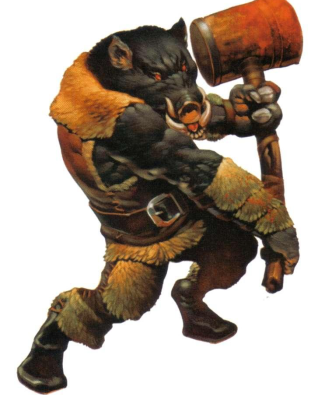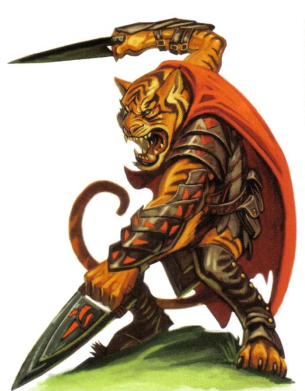Let's Read the 4e Monster Manual 2: Lycanthrope
The first Monster Manual had a Lycanthrope entry containing wererats and werewolves. Here in the second one we get stats for more types, as well as a bit of additional lore.
The Lore
I’ve covered a lot of the basic lore of lycanthropes in the [original article][2], so please read that. This entry adds a couple of other tidbits. The first one says that a lycanthrope’s natural form is the “beast-person” one. The other says that lycanthropes are Melora’s creations, and that the reason they’re affected by silver and the full moon is because of an ancient feud between Melora and Sehanine.
4e lycanthropes aren’t really forced to change in the full moon, so that’s not a big deal, but silver can shut down their regeneration. Like in the first MM, all the stat blocks we get here have “Evil” in their alignment, though there’s no real lore reason for all of lycanthropes to be evil.
The Numbers
Lycanthropes are natural humanoids, and the two we see here are Large. Obviously, they have the Shapechanger keyword. They have low light vision and a ground speed of 6 in either humanoid form or 8 in animal form. Switching forms is a minor action for them, giving them plenty of flexibility in a fight. They have regeneration, which shuts down for a turn when they’re wounded by silver weapons.
Victims damaged by a lycanthrope’s natural attacks while it’s in animal form are exposed to a disease specified alongside their stat block.
Wereboar

Wereboars are described as brutish and easily angered. Some of them like to hang out in places where a fight is likely to break out, such as in rowdy taverns and underground fight clubs. They love to fight in their animal form, and getting wounded only makes them angrier.
The stat block presented here is a Level 6 Brute with 61 HP and all traits listed above. Its regeneration is 5. He fights with a maul in human form and gores with his tusks in boar form. The tusks also inflict ongoing damage and transmit moontusk fever, the wereboar disease.
When bloodied, the wereboar gains a +2 to all defenses and doubles the amount of ongoing damage its tusks deal. And when it hits 0 HP, it can make one last basic attack before dying.
Moontusk fever is a level 6 disease with an “Improve” DC of 17 and a “maintain” DC of 12, and it fucks you up while you’re bloodied. Stage 1 inflicts a -2 penalty so taves while the victim is bloodied. Stage 2 limits them to one save at the end of their turn even if they’re affected by multiple save-ends effects. And the final stage gives you 5e disadvantage on that single save.
The disease isn’t directly lethal, but it’s a major inconvenience given how common saves are in this game. I imagine the actual level of the disease and its DCs should be equal to the level of the wereboar, if you’re changing them.
Weretiger

Weretigers are a marked contrast to their porcine relatives, being much sneakier and more opportunistic than them in a fight. If they become convinced they need to fight, they’ll stalk their adversary and strike in the most opportune moment. Their fighting style is highly mobile and cautious in any of their forms.
Weretigers are Level 11 Elite Skirmishers with 172 HP and Regeneration 10. They fight with paired katars in humanoid form, and with bites in tiger form. The katars are high-crit weapons and do more damage, but the bite transmits a disease called moon rage.
The weretiger can pounce when it charges, dealing more damage than a basic attack and knocking the target prone on a hit. Feline Fury allows it to make two basic attacks with a shift between them, and Slashing Recoil allows them to make a free basic attack when someone misses them in melee.
While this lycanthrope is stronger in humanoid form, there’s still some incentive to bite the PCs and expose as many of them as possible to moon rage. This is a disease that turns the victim’s hands into tiger paws! At stage 1 the partial change inflicts a -2 penalty on all attacks. At Stage 2 they gain a Strength-based claw attack that deals 1d6+STR bonus damage, but can no longer hold any weapons or implements. And at the final stage their mind is saddled with predatory instincts that prevent them from switching targets in combat until their current target is dead. At level 11, the Improve DC is 21 and the Maintain DC is 16.
Werewolf Lord
This is a bigger, stronger, smarter werewolf, usually found leading a whole clan of lycanthropes. They’re also known as “pack lords”. They’re mostly werewolves with bigger numbers, but they also have some useful leadership powers.
The lord is a Level 13 Elite Brute with 264 HP and Regeneration 10. They project a Blood Moon aura (5) that gives allies inside +2 to attacks and +5 to damage against bloodied targets. They fight with a falchion in humanoid form and with bites in wolf form.
The sword is a High-Crit weapon, and the bite transmits an enhnaced form of moon frenzy. Canine Fury allows them to make 2 basic attacks per action, and Speed of the Wolf allows them to shift 6 squares and bite when in wolf form. Finally, Savage Howl grants 15 temporary HP to every ally within 10 squares and allows them to make free bite attacks if they have any to make.
Greater Moon Frenzy is pretty much werewolf rabies, attacking the nervous system. Stage 1 is a -2 penalty to Will. Stage 2 has the victim make a save at the end of each turn to retain control of their actions. A failure means they must attack a random target within 5 squares or move in a random direction if there are no targets available. Stage 3 removes the save: the victim must attack the closest creature in sight or move in random directions until it finds any. As presented the disease is level 13, with an Improve DC of 23 and a Maintain DC of 18.
Sample Encounters and Final Impressions
I like that the lycanthrope diseases for the wereboar and weretiger are more inconvenient than lethal. A common complaint about 4e diseases is that they’re not very dangerous once the party gets access to the Remove Affliction ritual, which can happen from level 6 onwards. This is true, but curing afflictions can still spend time, money, and healing surges that would be useful elsewhere.
By having somewhat less dangerous diseases, wereboars and tigers paradoxically incentivize players to put up with them for a little longer and try to recover from them using the standard disease rules. So what if your saves suck when you’re bloodied? Just don’t get bloodied until you can return to town and recover!
We get three sample encounters:
-
Level 7: A human hexer, 2 half-orc hunters, and 2 wereboars. It’s either a big brawl in progress, or a group of rowdies looking to start one.
-
Level 12: An eladrin bladesinger, a will-o’-wisp, and 2 weretigers. Fey of a dark disposition who enjoy playing boogeymen and waylaying travelers.
-
Level 13: A werewolf lord, 3 standard werewolves, and 2 worgs. A powered-up version of the typical werewolf-led bandit gang.